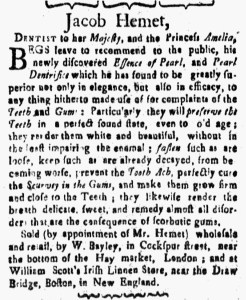What was advertised in a colonial American newspaper 250 years ago today?

“Also at NATHANIEL DABNEY’s Apothecary-Shop, at the Head of Hippocrates, Salem, New-England.”
Advertisements for Essence of Pearl and Pearl Dentifrice regularly appeared in newspapers printed in Boston in the early 1770s. According to the notice, Jacob Hemet, “DENTIST to her Majesty, and the Princess Amelia,” manufactured these products to “preserve the Teeth in a perfect sound State, even to old Age” as well as “render them white and beautiful,” “fasten such as are loose,” and prevent the Tooth-Ach.” Hemet’s products also helped with the gums. Supposedly they could “perfectly cure the Scurvy of the Gums,” “make them grow firm and close to the Teeth,” and “remedy almost all those Disorders that are the Consequence of scorbutic Gums.” Like many patent medicines, Essence of Pearl and Pearl Dentifrice had many uses for a variety of maladies.
Advertisements bearing Hemet’s name in capital letters as the primary headline and his occupation and service to royalty as the secondary headline appeared in several newspapers in Boston, including the February 18, 1773, edition of the Massachusetts Spy. Advertisements with identical copy also ran in the New-Hampshire Gazette, published in Portsmouth. Those notices indicated that Hemet appointed a select few agents to sell his products, “W. Bayley, Perfumer, in Cockspur-street, near the Bottom of the Hay-Market, London,” and William Scott at the “Irish Linen-Store, near the Draw-Bridge, Boston, New-England.” Those may not have been all of the associates that Hemet authorized to sell his products. Other advertisers included his Essence of Pearl and Pearl Dentifrice among lists of patent medicines and other merchandise, though they did not go into detail about the products. They may have expected that consumers were already familiar with them.
One advertiser, however, did attempt to establish a connection to Hemet and encourage readers to purchase the dentist’s products from him. For many months, Nathaniel Dabney took to the pages of the Essex Gazette, published in Salem, Massachusetts, with an advertisement that featured copy nearly identical to those in the New-Hampshire Gazette and the Boston newspapers … except he added himself to the list of authorized dealers: “also at NATHANIEL DABNEY’s Apothecary-Shop, at the Head of Hippocrates, Salem, New-England.” Residents of the town and readers of the only newspaper published there in the early 1770s likely would have been familiar with Dabney’s shop and the device that marked its location. The apothecary sometimes included images of “the Head of HIPPOCRATES” in his advertisements that listed a variety of patent medicines and other goods available at his shop. He did not publish advertisements for specific products, making the advertisement for Hemet’s Essence of Pearl and Pearl Dentifrice an exception. Had he entered into some sort of agreement with Hemet? Or had he acquired the products wholesale, perhaps from William Scott, and decided to take advantage of advertising copy already in circulation? Printers generated much of the news content by reprinting generously from one newspaper to another. Perhaps Dabney adopted a similar method in his efforts to market Hemet’s products. He likely would not have been the only advertiser to borrow copy from notices placed by others during the era of the American Revolution.

